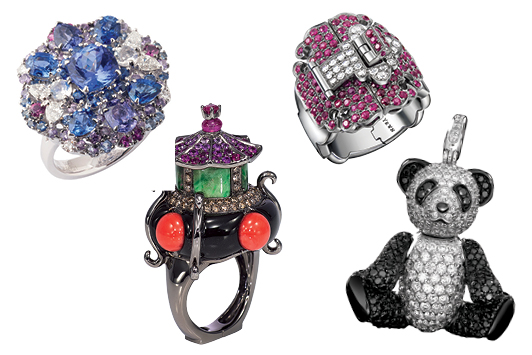
Green G.
Already a team in marriage, Sabina Lee and Paul Tsang joined business forces in 1997 to debut Green G. With her merchandising skills and his management experience, they built a Hong Kong-based jewelry firm with a signature of impressionist-inspired florals and Asian culture. Their new Monet collection recalls the 19th-century painter, and their Shangri-La ring, based on the fictional Chinese city, is encrusted with gemstone blooms. A Chinese poem influenced their Love Tree ring — an intertwined black-and-white design “signifying the image of cosmopolitan Hong Kong,” according to Lee.
She sketches designs that seasoned craftsmen in Hong Kong and China then bring to life in 18-karat gold, diamonds and gemstones. Her work has earned praise from the Hong Kong Trade Development Council, which has consistently promoted her jewelry to consumers “every year since the year I launched my brand,” she relates.
Starting retail price:
$1,000
Accounts: 10 in the United States, including Herkner Jewelers in Grand Rapids, Michigan
Trade fairs: The Hong Kong
International Jewellery Show, JCK Las Vegas, and the Hong Kong Jewellery &
Gem Fair
Retailer buy-in: None
Contact: Paul Tsang, Hong
Kong
(852) 2824-6128; paul@greengjewelry.com
Wendy Yue
Wendy Yue opened her eponymous design firm in Hong Kong in 2008 after ghost-designing for others for two decades. European travel at an early age and subsequent sketching to keep memories alive ultimately paved the way for her career; to recreate destinations, she made jewels in vivid color. Her aesthetic today speaks to many of those remembrances, along with her heritage. Storytelling is a goal; pieces in her Pagoda and Lantern collections resemble temples from childhood, while her use of black and white represents the bright city lights and calm night sky of Hong Kong.
“Recurring symbols include frogs, pagodas, monkeys and snakes — all of which have deeply rooted Chinese symbolism,” she days. Pieces are made in 18-karat gold with a wide variety of gems, including turquoise and malachite. Her mantra? Pieces have destined owners. “What you look for at the end of the day is the connection between the wearer and the piece,” she explains.
Starting retail price: $6,000
Accounts: 20 in the United
States, including Ikram in Chicago, Illinois
Trade fairs: Couture and
the Hong Kong Jewellery & Gem Fair
Retailer buy-in: A minimum
of 12 pieces
Contact: Wendy Yue, New
York City
(646) 603-6946; yozora@wendyyue.com
Yewn
One-time student of French culture Dickson Yewn redirected his energy into jewelry studies at New York’s Fashion Institute of Technology (FIT) and became a designer. Yewn founded his namesake outfit in 2000 in Hong Kong, unveiling a contemporary Chinese vibe rich in cultural symbols such as longevity locks, bats and lucky clouds. Most notable are his square-shaped rings in wood and 18-karat gold, featuring auspicious motifs and Chinese architectural designs like lattice.
He spurns the “commercial style” of many Chinese makers, instead creating styles “in tune with China’s 5,000-year arts-and-crafts evolution,” he says. “Most designers who are from Hong Kong and China seem to have amnesia of their own cultural background.” Pieces are made in China, Thailand and Europe with diamonds, pearls, jadeite and other precious stones.
Starting retail price:
$1,920
Accounts: Two in the United
States, including Aman Jewelers in Corpus Christi and Victoria, Texas
Trade fairs: Brafa Art
Fair, Contemporary Art Fair Zurich, Asia Contemporary Art Show, Asia Week Hong
Kong, Asia Week of New York, Asian Art in London, and Fine Art Asia
Retailer buy-in: 10 pieces
Contact: Dickson Yewn, Hong
Kong
(852) 2868-3890; info@yewn.com
Qeelin (Kering)
After training at the Hong Kong Polytechnic University and under product designer Ken K. Shimasaki, Dennis Chan debuted Qeelin (now part of Paris-based luxury group Kering) in 2004. Chan’s declared goal: To “bring the best of contemporary Chinese design to the world.” His first collection, dubbed Wulu, is a nod to the lucky number eight, a shape that also evokes the legendary Chinese tale of the wulu, or gourd — “an auspicious emblem in Chinese tradition,” Chan says.
More symbolism is evident in his Bo Bo, or panda, collection and his Yu Yi jewelry, which represents a symbol of protection. Even the name Qeelin has meaning: It relates to Qilin, “a Chinese mythical animal and icon of love,” explains Chan, who has won honors from the Singapore Design Awards, among others. The pieces are made in Europe and Asia from 18-karat gold with diamonds and other gems. “Qeelin has embraced the evocative myths of the East…to deliver a beguiling combination of poise, playfulness, imaginative whimsy and enchanting oriental beauty,” says Chan.
Starting retail price:
$1,270
Accounts: 10 US outlets,
including Reinhold Jewelers in San Juan, Puerto Rico
Trade fairs: Couture
Retailer buy-in: $100,000
Contact: Qeelin at the
Anima Group, NYC
(800) 868-5533; info@anima-group.com
Image (left to right): Green G.; Wendy Yue; Yewn; Qeelin (Kering)
Article from the Rapaport Magazine - September 2017. To subscribe click here.